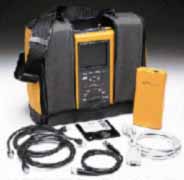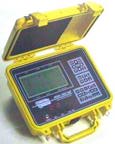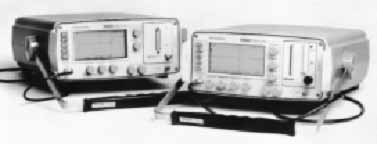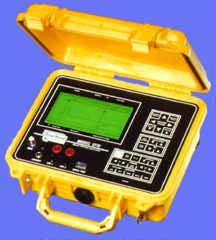



Time Domain Reflectometers



Dry Line TDRs
A dry line TDR is used to locate anomalies on cabling used for networks, PBX systems, and "in-house" wiring systems.
The Fluke DSP-100sr, DSP-2000, and DSP-41000 are the best units available and should be used with either "smart remotes" or dual units back to back.
The DSP-100sr/2000/4000 will locate virtually any type of capacitively or inductively isolated bug, high impedance device, or slave unit (if used properly).
The Microtest Pentascanner is an older unit, but performs well as a backup unit.


Wet Line TDRs
A wet line TDR is used to locate anomalies on cabling used for telephone and data communications with live voltages and signals. This type of instrument is most useful when you can only gain access to one end of the circuit.
The Riser-Bond 1200 series dual lead TDR is recommended for field usage and tracing phone lines in an "outside-plant" environment.
Authors Rant About Proper TDR Usage
The Tektronix 1502 and 1503 TDR is an older style design, but can be used to check wiring provided that there is no signal or voltage present on the lines under test. The 1502 is a high precision unit suitable for use on cable runs under a few hundred feet, with the 1503 being a more general purpose unit for longer cable runs.
Neither the 1502 or 1503 is appropriate for use on live telephone lines, and you risk seriously damaging the instrument if subject to such usage.
Not only will you NOT get a decent reading, you will screw up the sensitivity on the sampler circuit, and you could blow out the entire front end of your unit. While the damage may not show up immediately, you are doing damage nonetheless.
The 1500 series is a DRY LINE TDR in that it can only be used on a circuit that has less then five volts DC or AC on it. Because of this they are far more sensitive then a wet line TDR (such as the Riser Bond units).
If you need a dry line unit use a Fluke DSP or Tektronix unit, but if you want a wet TDR for use on live lines use the Riser Bond or similar unit. The 1500 series is STRICTLY a dry line TDR unless it has the Ethernet option, and even then it is for WET ETHERNET, but DRY "everything else".
This author would point out that VR3021 and VR3020 in the 1500 are 5.6 volt diodes on the front end, and that they will "go poof" if you apply loop voltage for anything more then a few milli-seconds. The A6 Ethernet Board bumps these voltages up a bit, but it is still no where near the voltages found on normal phone lines.
In the event that you are lucky enough to have the TDR connected when ring voltage is applied you can expect to damage the unit (which will permanently degrade performance, but may not totally kill the unit).
The unit are designed to handle PERIODIC applications up to 400 volts, but it is ill-advised to every apply more then 11.2 volts or you will get screwed up readings.
If you get into a pinch and have to use a 1500 series on a wet line then add a cap in series to kill the DC, and a couple of switching diodes to kill anything over 6 volts (and of course a set of zener diodes). A small impedance matching circuit will also be helpful.
Remember the 1500 was designed (many years ago) to test the cabling on antenna's (involving a 300 mV signal), not telephone loop circuits (with almost 50 volts).
The author uses and owns both the CRT and LCD versions of the 1502 and 1503, several Riser Bond units, 3-4 Flukes, and several Microtest units along with several dual and quad lead ping boxes.
Lean towards the Fluke DSP-4000 for testing "station wiring", Riser Bond 6000 or 1270 dual lead for wet telephone lines.
Use the Tektronix 1502 for short DRY telephone lines, DRY coax, HVAC wiring, intercom wiring, etc (this is perfect for things that are less then 200 foot). The Tektronix 1503 is good for long DRY telephone line, or for longer runs of DRY wire the 1502 can not develop enough voltage to ping.
For general purposes have several ping boxes you can use to convert a hand-held O'scope into a TDR. These boxes are good when you have to perform a TDR on live power lines, alarm lines, HVAC wires, etc).
Let me say again... do not connect the 1502 or 1503 into a live circuit.
![]() Time Domain Reflectometry Tutorial
Time Domain Reflectometry Tutorial

| Spectrum Analyzers
| Vector Signal Analysers
| Demodulation
| Time Domain Reflectometers
|
| Antenna
| Oscilloscopes
| Multimeters
| Craft Instruments
| TSCM Specific Instruments
|
| Non Linear Junction Detectors
| Acoustic
| Physical Search
| Photographic and Imaging
|
| Auxillary
| Ancillary
| Video
| Vehicles
|
![]()
|
To be contacted for a confidential consultation please E-mail: jmatk@tscm.com
or send a letter via US Mail to:
or call:
URL: http://www.tscm.com/ |